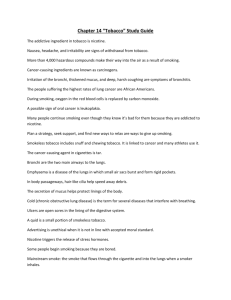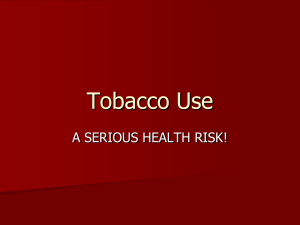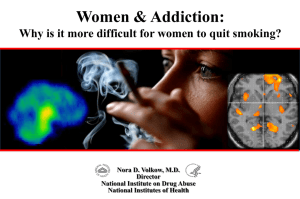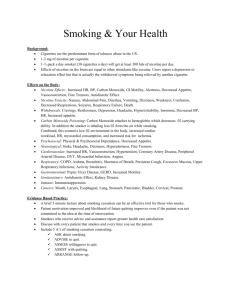Nicotine 11/11/2013
advertisement
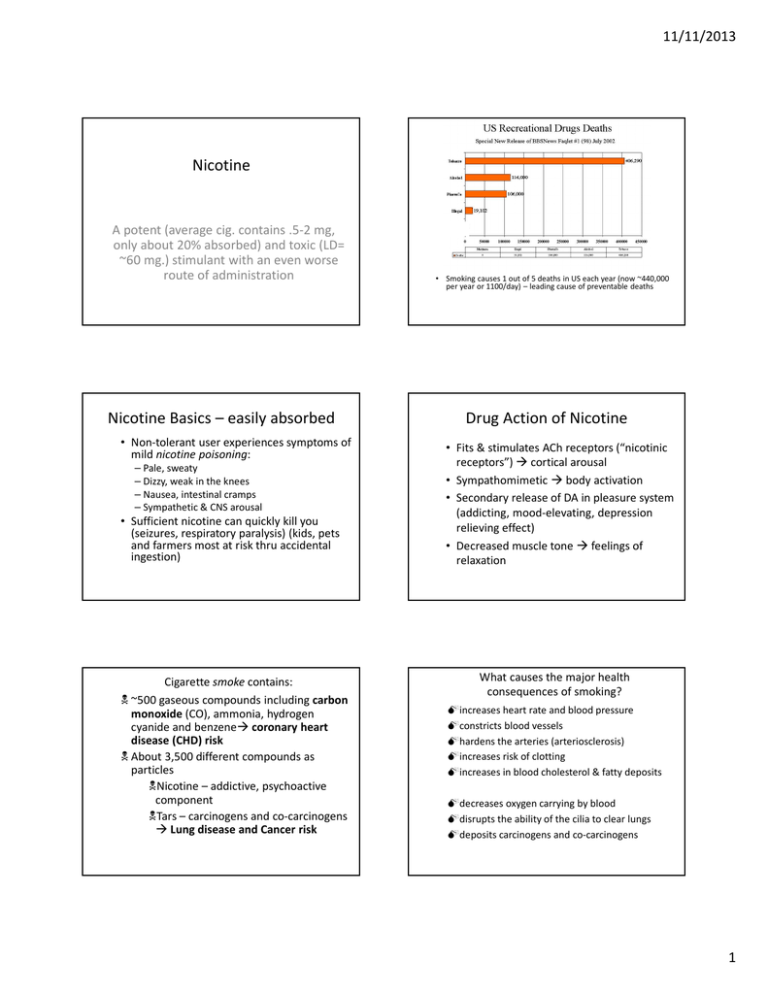
11/11/2013 Nicotine A potent (average cig. contains .5-2 mg, only about 20% absorbed) and toxic (LD= ~60 mg.) stimulant with an even worse route of administration Nicotine Basics – easily absorbed • Non-tolerant user experiences symptoms of mild nicotine poisoning: – Pale, sweaty – Dizzy, weak in the knees – Nausea, intestinal cramps – Sympathetic & CNS arousal • Sufficient nicotine can quickly kill you (seizures, respiratory paralysis) (kids, pets and farmers most at risk thru accidental ingestion) Cigarette smoke contains: ~500 gaseous compounds including carbon monoxide (CO), ammonia, hydrogen cyanide and benzene coronary heart disease (CHD) risk About 3,500 different compounds as particles Nicotine – addictive, psychoactive component Tars – carcinogens and co-carcinogens Lung disease and Cancer risk • Smoking causes 1 out of 5 deaths in US each year (now ~440,000 per year or 1100/day) – leading cause of preventable deaths Drug Action of Nicotine • Fits & stimulates ACh receptors (“nicotinic receptors”) cortical arousal • Sympathomimetic body activation • Secondary release of DA in pleasure system (addicting, mood-elevating, depression relieving effect) • Decreased muscle tone feelings of relaxation What causes the major health consequences of smoking? increases heart rate and blood pressure constricts blood vessels hardens the arteries (arteriosclerosis) increases risk of clotting increases in blood cholesterol & fatty deposits decreases oxygen carrying by blood disrupts the ability of the cilia to clear lungs deposits carcinogens and co-carcinogens 1 11/11/2013 Risk: Cardiovascular Disease > 200,000 deaths/yr • Risk of coronary heart disease & heart attack doubles (quadruples in heavy smokers) Other Effects of Smoking • Increases risk of almost every • cancer – Pancreas, liver, bladder • – Cervix, colorectal – Voicebox, mouth, throat • – Lung cancer spreads to other locations • Increased stroke and other vascular disease Macular degeneration of center of retina Gum disease; tooth decay & loss Aging of skin, wrinkles, psoriasis http://www.youtube.co m/watch?v=3aIeF5Lja Dk Fetal Tobacco Syndrome • Smoking during pregnancy produces a dosedependent decrease in oxygen to the baby, resulting in: – shorter, lighter babies with smaller heads – dose-related risk of miscarriage, placental problems, bleeding, stillbirth, prematurity, neonatal death – some studies show small but consistent increases in SIDS, learning difficulties, hyperactivity and ↓IQ in kids born to smoking moms vs non-smoking moms, and ↑risk of conduct, oppositional defiant and substance abuse disorders as they get older but some of these may be related to genetic factors – Health problems increase with continued smoking in home. Risk: Respiratory Disease • Lung Cancer (~115,000 deaths/yr) • Chronic Obstructive Lung Diseases like emphysema & bronchitis (~82,000/yr) • Increased respiratory infections Other Smoking Concerns • Passive smoking (second-hand smoke) is a serious problem – Almost 60 percent of U.S. children aged 3–11 years—or almost 22 million children—are exposed to secondhand smoke. – Secondhand smoke exposure causes about 3,000 lung cancer deaths and 46,000 heart disease deaths annually among adult nonsmokers in the United States. – If you live or work full time in a smoking environment, you are likely to have blood levels of smoking chemicals equivalent to a light smoker Myth of the Safer Cigarette • To maintain customer satisfaction, filtered cigarettes use a high T/N tobacco, counteracting the benefit of the filter and raising the toxicity of sidestream smoke. • Low T/N numbers on pack are NOT accurate reflections of the T/N user gets • http://www.youtube.com/watch?v=yZZ_Tor3 3Ms • http://www.cancer.gov/cancertopics/factshe et/Tobacco/light-cigarettes 2 11/11/2013 What About Smokeless Tobacco? No inhaled gases, but still Chewing tobacco exposed to carcinogens & Dip addiction Nasal Snuff Snus (Scandinavian) (regulated as a food product) • Snus (American) (unregulated) • http://www.youtube.com/watch?v=IF3gldw9D0 • http://www.cbsnews.com/video/watch/?id =6362540n • • • • The New “Chew” – may be more discrete but still addictive & cancer-causing •Nicotine Transdermal Patch Withdrawal Symptoms • Drowsy, depressed, decreased concentration, brain less aroused • Restlessness, anxiety, irritability • Headache, sweating, decreased HR & metabolism, GI complaints, sleep disturbances • Craving • (Bold items increased if you use caffeine) • Behavioral habits may be even more important than withdrawal 16 & 24 hr, Latter causes more sleep difficulties & vivid dreams Former causes more morning craving. 3 doses allow step down in dose when desired. Highest compliance; sustained nicotine release Rash possible; keep changing location Even if you stay on patch the major health risks of tobacco are avoided. Staying on patch decreases relapse. Nicotine Gum or Polacrilex; Nicotine Lozenge or “Candy” Nicotrol Nasal Spray Also 2 mg dose • Not really gum- chew a little then “park” in cheek; repeat over 30 minutes. Do not consume sodas or other acid beverages while using. Follow directions to be sure you use enough & use long enough to get desired effectiveness. • Nicotine lozenge should not be chewed. Generic form available. • Fast delivery of a jolt of nicotine (more like a cigarette) but this also means greater risk of dependency on spray 3 11/11/2013 Pharmacological Approaches Nicotrol Inhaler & E-Cigarettes • Nicotine replacement therapies – Nicorette chewing gum – Nicotine patch – Nicotine inhaler; e-cigarette – Nicotine nasal spray – Nicotine lozenge • Avoids withdrawal symptoms while breaking behavioral habit – up to double the success rate • Even if you stay on nicotine replacement, tremendous health benefits by eliminating the other components of tobacco/smoking Administered more like a cigarette – satisfies some “behavioral habits (may be good for some users) BUT: e-cigs are currently not considered “drugs”, are not regulated by the FDA, have not been tested for safety, nor is there quality control. FDA tests revealed inconsistant nicotine doses and some contain tobacco-associated carcinogens!! • http://www.youtube.com/watch?v=nASxOVKj ciY http://www.msnbc.msn.com/id/46401133/ns/health-addictions/#.UGRvr64w_nh Newest: Chantix (varenicline) Zyban/Wellbutrin (sustained release bupropion) (also another antidep nortriptyline (Pamelor, Aventyl) • Seem to relieve mood changes of withdrawal, ↓craving, ↓ wt. gain and ↑ short term & long-term smoking cessation. Don’t have to be depressed to benefit from these. • Also evidence that success rate is doubled compared to placebo. • Combined counseling/support with pharmacotherapies even better. • http://www.youtube.com/watch?v=aNgox9EPha0 Some Behavioral Approaches • Stimulus control (avoid smoking situations; make tobacco less available) • Visualize smoking consequences – think about your dirty black lungs & shrunken coronary arteries each time you light up • Find “substitutes”: relaxation training, exercise • Contingency contracting – rewarding your quitting success • Social support (buddy system; groups) • Aversion therapy – rapid smoking protocol • Partial agonist slightly stimulating, then blocking nicotine receptors • Decreases withdrawal symptoms & produces some nicotine-like effects on mood • Because Chantix blocks nicotine from binding, smoking is not as reinforcing; quitting is not as aversive • Side effects: nausea, bizarre dreams, possible neuropsychiatric symps in some (hostility, agitation, depression, suicide) • http://www.webmd.com/smoking-cessation/news/20090701/warning-on-stopsmoking-drugs-chantix-zyban Stop smoking? • Two-thirds of smokers would like to quit, • 30-33% try to quit in any year, 2/3 smoke in two days, 97% in 6 months • Several attempts typically precede success • Relapse rate lower in those who do a smoking cessation program. About a 20-30% success (long-term abstinence) on average. • Over 40% continue to smoke after laryngectomy, more 50% after a heart attack – very powerful addiction 4




